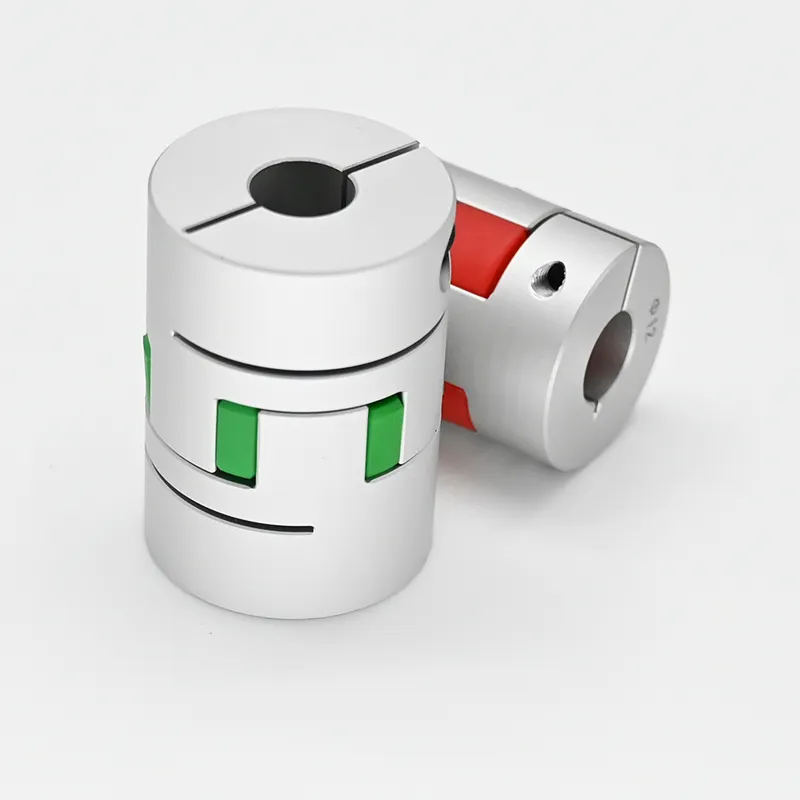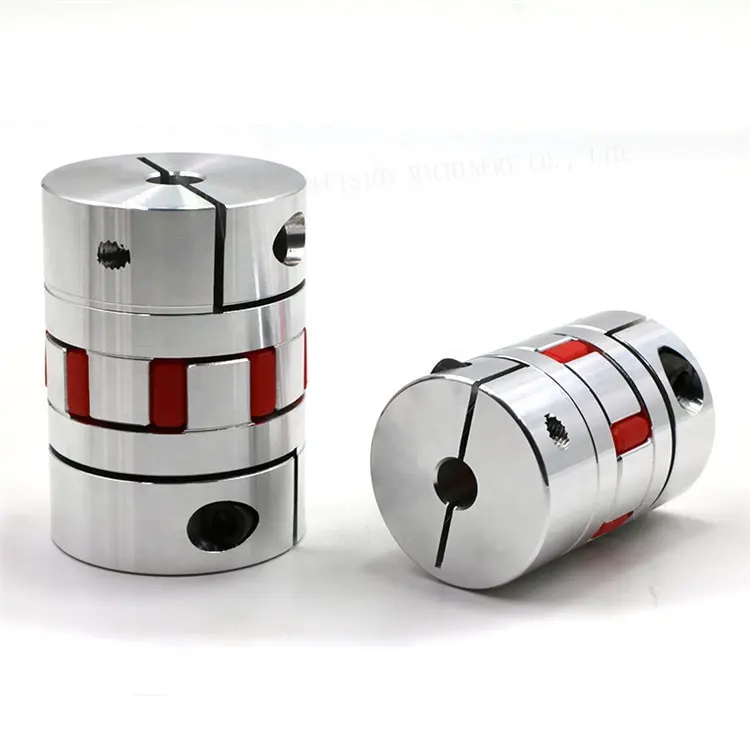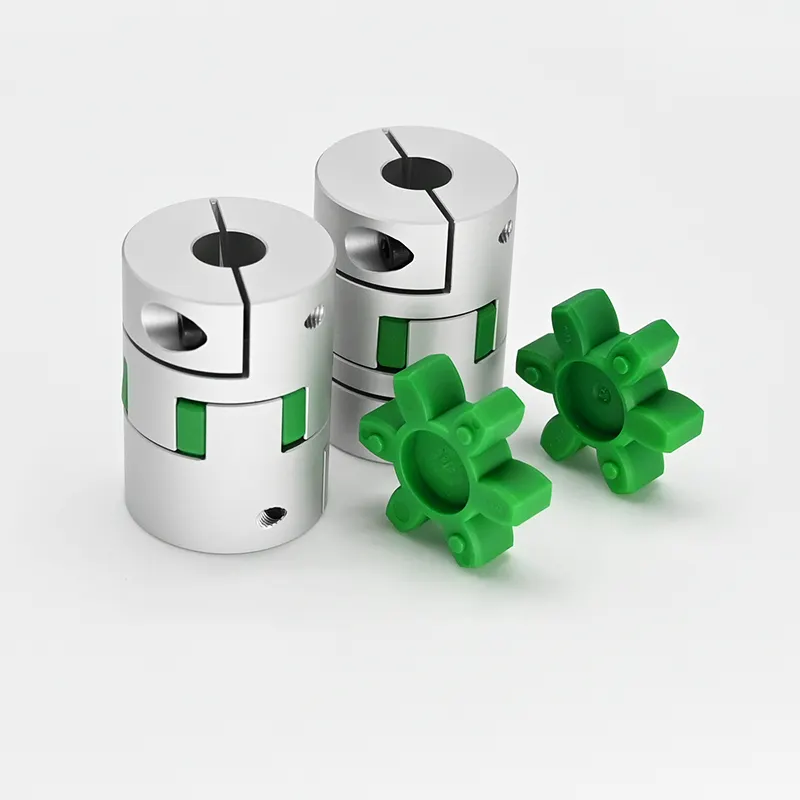Product Description
LMS Model Flexible Double flange type jaw coupling for pump
Description:
A jaw coupling is a type of general purpose power transmission coupling that also can be used in motion control (servo) applications. It is designed to transmit torque (by connecting 2 shafts) while damping system vibrations and accommodating misalignment, which protects other components from damage. Jaw couplings are composed of 3 parts: 2 metallic hubs and an elastomer insert called an element, but commonly referred to as a "spider". The 3 parts press fit together with a jaw from each hub fitted alternately with the lobes of the spider. Jaw coupling torque is transmitted through the elastomer lobes in compression.
The elastomer of the spider can be made in different materials and hardness, which allows the user to customize the coupling to best serve their application. Considerations for elastomer selection include ability to dampen vibration, ability to handle misalignment, operational temperature range, speed of equipment, and chemical conditions.
Features of LMS double flange flexible jaw coupling:
1.For heavy machinery
2.Easy assblemly
3.Cut off power when installation
4.Can replace elastomer/spider withour moving driving and driven equipment.
Scope and performance characteristics:
LMS (formerly MLS) type - double flange type plum-shaped elastic coupling plum-shaped elastic coupling has the following characteristics: flower-shaped elastic coupling has simple structure, small radial size, light weight and small moment of inertia. In medium and high speed applications, the plum-shaped elastic coupling works stably and reliably, and has good vibration damping, cushioning and electrical insulation properties. Plum-shaped elastic coupling has large axial, radial and angular compensation ability. High-strength polyurethane elastic components of plum-shaped elastic coupling are wear-resistant and oil-resistant, with large bearing capacity, long service life, safe and reliable, and coupling. No lubrication, no maintenance, continuous operation for a long time.
Plum-shaped flexible couplings are mainly suitable for starting, frequent reversing, medium and high speed, medium torque and high reliability requirements, such as metallurgy, mining, petroleum, chemical, lifting, transportation, light industry, textile, Pumps, fans, etc. Working environment temperature -35 ° C ~ +80 ° C, the transmission of nominal torque 25 ~ 12500Nm, the allowable speed of 1500 ~ 15300r / min.
The ML series plum-shaped elastic coupling is mainly engaged by 2 convex teeth and is subjected to radial compression to transmit torque. When the 2 axes are relatively offset, the elastic elements are elastically deformed correspondingly to automatically compensate.
Packing & shipping:
1 Prevent from damage.
2. As customers' requirements, in perfect condition.
3. Delivery : As per contract delivery on time
4. Shipping : As per client request. We can accept CIF, Door to Door etc. or client authorized agent we supply all the necessary assistant.
FAQ:
Q 1: Are you a trading company or a manufacturer?
A: We are a professional manufacturer specializing in manufacturing various series of couplings.
Q 2:Can you do OEM?
Yes, we can. We can do OEM & ODM for all the customers with customized artworks in PDF or AI format.
Q 3:How long is your delivery time?
Generally, it is 20-30 days if the goods are not in stock. It is according to quantity.
Q 4: How long is your warranty?
A: Our Warranty is 12 months under normal circumstances.
Q 5: Do you have inspection procedures for coupling?
A:100% self-inspection before packing.
Q 6: Can I have a visit to your factory before the order?
A: Sure, welcome to visit our factory.
/* January 22, 2571 19:08:37 */!function(){function s(e,r){var a,o={};try{e&&e.split(",").forEach(function(e,t){e&&(a=e.match(/(.*?):(.*)$/))&&1

Use of Jaw Couplings in Food Processing and Pharmaceutical Industries
Jaw couplings can be used in food processing and pharmaceutical industries under certain conditions and with the appropriate materials and design considerations. These industries have strict regulations and requirements regarding hygiene, contamination prevention, and cleanability. Here are some key factors to consider:
- Material Selection: For applications in food processing and pharmaceutical industries, jaw couplings must be made from materials that meet FDA and/or other regulatory standards for food contact and pharmaceutical use. Stainless steel or FDA-approved plastics are commonly used in such applications.
- Cleanability: The design of the jaw coupling should allow for easy cleaning and sanitization. Smooth surfaces and minimal crevices help prevent the accumulation of debris and bacteria. Hygienic designs are crucial to ensure compliance with industry standards.
- Sealing: Proper sealing is essential to prevent any lubricants or contaminants from escaping the coupling and coming into contact with the processed materials. Seal materials must be compatible with the substances used in the industry.
- Corrosion Resistance: In food processing and pharmaceutical environments, equipment is often subjected to aggressive cleaning agents and chemicals. Jaw couplings must be corrosion-resistant to withstand these harsh conditions and maintain their performance over time.
- Compliance with Regulations: Industries such as food processing and pharmaceuticals have specific regulatory standards, such as those set by the FDA (Food and Drug Administration) or other relevant authorities. The jaw couplings used in these applications must meet all necessary regulations to ensure product safety and consumer confidence.
It is important to note that while jaw couplings can be suitable for certain applications in food processing and pharmaceutical industries, it is essential to work closely with coupling manufacturers and suppliers to ensure that the selected couplings meet all industry-specific requirements and standards. Additionally, regular maintenance and inspection should be carried out to ensure the couplings continue to perform as expected and comply with hygiene and safety regulations.

What are the real-world applications of jaw couplings in various industries?
Jaw couplings find extensive use in various industries due to their versatility, ease of installation, and ability to handle misalignment. Their robust design and flexible elastomer spider make them suitable for a wide range of applications. Here are some real-world applications of jaw couplings in different industries:
- Industrial Machinery: Jaw couplings are commonly used in industrial machinery for power transmission between motors and driven equipment. They are found in conveyor systems, pumps, fans, compressors, mixers, and other rotating equipment. Their ability to compensate for misalignment and dampen vibrations makes them ideal for such applications.
- Agriculture: In agricultural equipment, jaw couplings are employed to transfer power from tractors or other power sources to various implements such as plows, mowers, and harvesters. The couplings' resistance to shock and impact loads makes them suitable for the rugged conditions encountered in agricultural operations.
- Construction and Mining: Jaw couplings are used in construction and mining machinery to transmit power between engines and equipment like concrete mixers, excavators, rock crushers, and conveyor systems. The couplings' ability to handle misalignment and shock loads is beneficial in these demanding and dynamic environments.
- Material Handling: Jaw couplings are employed in material handling systems, including automated production lines and warehouse conveyors. They facilitate smooth power transmission in equipment like belt conveyors, bucket elevators, and packaging machines.
- Marine: In the marine industry, jaw couplings are used in propulsion systems to connect engines to propellers and other equipment. Their resistance to corrosion and ability to handle misalignment make them suitable for marine applications in various vessels, including boats and ships.
- Printing and Packaging: Jaw couplings are used in printing and packaging machinery to drive rollers, slitters, and other components. Their precise torque transmission and ability to handle small misalignments contribute to the smooth operation of these machines.
- Automotive: In the automotive sector, jaw couplings are used in various applications, including power steering systems, engine-driven accessories, and HVAC blowers. Their compact design and efficient power transmission characteristics are well-suited for automotive applications.
- Textile: Jaw couplings are used in textile machinery to drive spinning frames, looms, and other textile processing equipment. Their ability to handle misalignment and provide smooth power transmission is vital in maintaining the precision required for textile production.
- Medical Equipment: Jaw couplings are utilized in medical devices and equipment to transfer power between motors and driven components. Their compact size and quiet operation are advantageous for various medical applications.
- Renewable Energy: Jaw couplings are used in renewable energy applications, such as wind turbines and solar tracking systems, to transmit power between the generator and other components. Their ability to handle misalignment is beneficial in these dynamically changing environments.
In summary, jaw couplings have widespread applications across multiple industries due to their ability to handle misalignment, dampen vibrations, and provide efficient power transmission. Their adaptability and reliability make them a popular choice for various mechanical systems in different sectors.

Types of Jaw Coupling Designs
Jaw couplings come in various designs to meet different application requirements. The main types include:
- One-Piece Jaw Coupling: This design consists of a single piece of material, typically made of steel or aluminum. It offers simplicity and compactness, making it suitable for light to medium-duty applications.
- Two-Piece Jaw Coupling: This design features two separate hubs with a flexible spider placed in between. The two-piece design allows for easier assembly and disassembly, making it convenient for maintenance and replacement of the elastomeric spider.
- Three-Piece Jaw Coupling: In this design, the coupling includes three parts: two hubs and an insert. The hubs are typically made of metal, while the insert is an elastomeric element (spider). Three-piece jaw couplings provide better damping of vibrations and are commonly used in applications where vibration isolation is crucial.
- Customizable Jaw Coupling: Some manufacturers offer customizable jaw couplings, allowing customers to choose different hub styles, materials, and spider hardness to tailor the coupling's performance for specific applications.
Each design has its advantages and is selected based on factors such as torque requirements, misalignment compensation, and ease of maintenance.


editor by CX 2024-05-16
